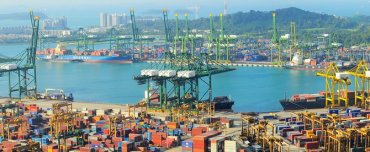Fully 53 percent of the worlds thirst for marine lubricants springs now from Asia, an official with Total Lubmarine told a recent industry conference. Its a vital region for any lubricant player in this 2.1 million metric ton market.
The global trade in marine lubricants, including cylinder oils, trunk piston engine oils and other shipboard lubes, comprises just 5 percent of total lubricants demand, the companys Marie Braouezec indicated last month.

Jo – fotolia
Asia-Pacific is the world’s largest marine lubricant market, thanks to thriving ports such as Singapore.
Change tended to come at a stately pace in this market, she said, until the past two years. Marine lubes now are in the doldrums, with little growth expected for at least five years, thanks to overbuilding of vessels, waning ship utilization rates and a general slowdown in economic activity.
Other headwinds are blowing too: the need to formulate lubricants that satisfy pollution control mandates; ship owners demands for inventory efficiency; and waning supplies of heavy base oils for making the viscosity grades that marine engines have traditionally favored.
Looking back, the trend over the past 10 years was pretty nice – really not bad, Braouezec told the ICIS Pan American Base Oils and Lubricants Conference in New Jersey on Dec. 4. But the marine lubricants market outlook is flat, she added emphatically. It will only reach 2.2 million metric tons in 2023.
One of the biggest changes this market has seen is the shift in trade from west to east, she continued. Over 100,000 vessels ply the globes waters, including 60,000 deep sea vessels. Many of these carriers used to register under the flags of maritime havens like Panama, Liberia and Greece. But they increasingly fly Asian flags now: Marshall Islands, Hong Kong, Singapore and China all have berths in the list of top 10 flags.
However, the real key to sea power is who owns these ships, reminded Braouezec, because ship-owning countries have nothing to do with flags. She quickly limned the picture:
- Half of the top 10 ship-owning countries are Asian: Japan, China, South Korea, Singapore and Taiwan.
- The majority of the top 10 shipping companies are Asian, too. They include NYK, Mitsui OSK, Cosco, Kawasaki Kisen, China Shipping and CMA CGM.
- Nine of the worlds top 10 container ports are in Asia, and the other is in the Middle East. Europe and the Americas have been pushed from the list.
Not to be left behind, Total Lubmarine has joined this migration. On Dec. 17, its first batch of marine lubricants was manufactured at Totals new blending plant in Tuas, Singapore. The plant, which opened in July, is Totals largest worldwide. It has a jetty directly on the sea which can load these products onto delivery and supply vessels. Three 900 dwt double-hulled barges, operated by logistics partner Ocean Tankers, can take marine lubricants directly from the Tuas jetty to waiting ships.
Total Lubmarine estimates that a small container ship can consume 50 tons per year of cylinder lubricant, and a large ship may eat 200 tons, said Braouezec, who is Lubmarines general manager, Americas. A lot depends on the speed of the vessel, and the big goal for ship owners is to find the right balance between the size of the vessel and the optimum speed.
To save money at sea, ship owners are downsizing engines, using longer strokes, steaming more slowly and often burning dual fuels. All this puts stress on the lubricants.
Ships also must satisfy pollution control measures such as the Emissions Control Areas ordered by the U.N. International Maritime Organization. When operating within ECA regions, ships can only burn fuel with less than 0.1 percent sulfur, and they also face strict restrictions on emissions of NOx and CO2. Operators must adopt lubricants with much lower base number (BN) in these regions as well, to further limit their emissions.
The effect of all these changes has been a new phenomenon: cold corrosion. One tool to combat this is a very high BN cylinder oil, of around 100, versus the BN 70 that was more common before. Very high BN runs afoul of the ECA restrictions though, meaning that ships often must carry two, three or possibly five lubricants to comply with all the operating conditions they face.
Blending these lubricants is growing in difficulty as heavy grades of API Group I base oils are in tight supply. Asked if API Group I base oils will continue to be the primary choice for making marine lubricants, Braouezec replied, No, because we have no choice. Marine lubricants are small, and we cannot dictate what refiners make. But we at least need to have heavy grades.
Also extremely short is bright stock for making SAE 50 grade oil, which big engine [original equipment manufacturers] like Wartsila wont move from, she said. Were still trying to convince them that using SAE 40 might be viable, because at least that grade can be produced without the use of bright stock.
The biggest issue right now is idling vessels, Braouezec said. Overbuilding has collided with slowing economic growth, and too many vessels today are chasing too few cargoes.
The result is that utilization is falling, including for the worlds biggest container ships. The unfortunate impact, she added ruefully, is that in the coming year some ships wont be buying lubricants at all.
